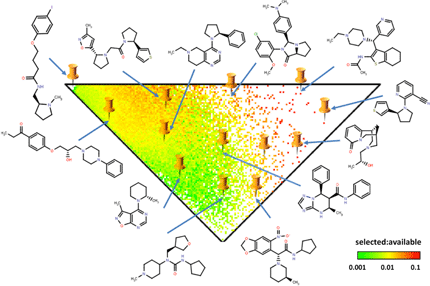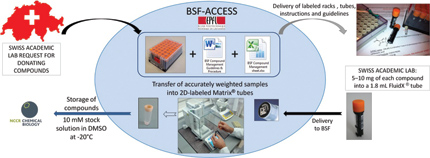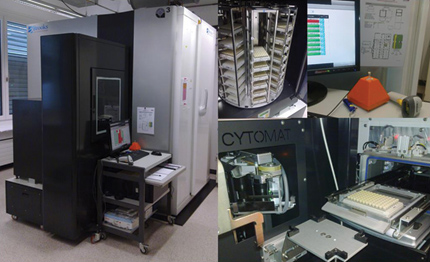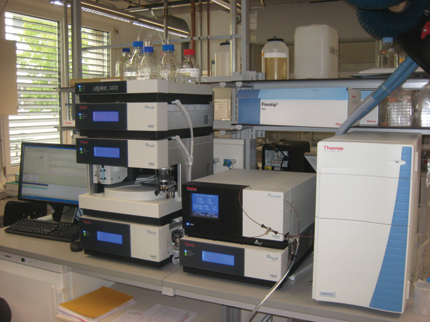The EPFL-Biomolecular Screening Facility
The Biomolecular Screening Facility (BSF) is an EPFL-founded multidisciplinary laboratory created in 2006 for performing high throughput screening in life sciences-related projects. The platform conceived with a long-term vision was constructed following a development plan according to the broad range of research environment needs rather than to privilege a particular biological discipline or therapeutic area. Therefore, over the years, the BSF has been performing screening campaigns in the major fields (but not limited) of Cancer Research1-2, Neurobiology3-4 and Infectious Diseases5 for researchers interested in Drug Discovery, Chemical Biology and Systems Biology. Our ‘generic’ and flexible model in terms of field of applications has also been extended and is reflected by the variety of assays proposed and diversity of available compounds collections. Briefly, the BSF performs a variety of assays in 96 and 384 well plate format for in vitro biochemical target-based and cellular assays including image-based phenotypic screens (High Content Screening).using libraries of synthetic chemicals, natural products and synthetic RNA duplexes (siRNAs) for gene known-down assays.
Developing the screening platform
After validating the platform by delivering results from screening campaigns from the local EPFL and associated environment, it has been planned and expected a natural extension of our activities through the interaction with country wide networks, initiatives or national programs. Early on, in 2007, a first development in this direction was possible thanks to the integration of the BSF platform in the Swiss Initiative for Systems Biology (www.systemsx.ch) that allowed the platform to specialize in large-scale gene knock-down screens using whole genome siRNAs collections principally through informative screening by imaging assays6-8. A more recent critical development is in the frame of the National Centre of Competences in Research (NCCR)-Chemical Biology leaded by the University of Geneva and the EPFL (www.nccr-chembio.ch). In this context, the BSF is hosting ‘ACCESS’, An Academic Chemical Screening Platform for Switzerland.
The NCCR for Chemical Biology
The National Centre of Competence in Research (NCCR) «Chemical Biology – Visualisation and Control of Biological Processes Using Chemistry» has as a main mission to use chemistry tools to obtain a better understanding of life at the molecular level9. Until now, few technologies could characterize in detail the countless biochemical activities that constitute a living cell. In the NCCR Chemical Biology, chemists, biochemists, physicists and cell biologists develop innovative techniques based on small molecules and proteins to obtain new information about cellular processes and control them in situ. The new tools will be applicable to various biological phenomena like visualizing the activity of selected proteins during cell division and investigating how membranes control the activity of proteins in them. The NCCR is also engaged in establishing a platform (ACCESS) for chemical screening aimed at developing a new generation of molecules with biological effects.
ACCESS
It is therefore one of the goals of this NCCR to establish a platform that provides the scientific community in Switzerland with chemical diversity, screening facilities and know-how in chemical genetics. ACCESS, the platform for Academic Chemical Screens in Switzerland centralized at the EPFL-BSF is becoming a focal point of this NCCR and should permit the Swiss scientific community to profit from the enormous possibilities of chemical biology.
The BSF actively participated in the preparation of this NCCR project and in particular for elaborating the plan for further developing the existing platform in a national specialized center for chemical screens. The main objectives and developments carried out during the first three years of this NCCR are described as follows:
- Increasing the available chemical diversity at the BSF; building the ACCESS chemical collection
- Develop and implement a strategy for collecting compounds from academic organic chemistry labs: The Swiss Chemical collection
- Definition and validation of the compound management instrumental infrastructure and standard operating procedures for handling and controlling the chemical integrity of chemicals.
- Opening an ACCESS antenna at the University of Geneva with selected screening instrumentation including an automated screening microscope for allowing faster progression of in house projects.
- Performing chemical screens for the NCCR-Chem Biol partners and moving forward with pilot NCCR-Chem Biol projects towards lead optimization.
Opening the access of the platform to Swiss academic and non profit-research institutions
The ACCESS chemical collection is reaching 100’000 compounds
Thanks to an important instrumental infrastructure, the BSF has been performing screenings since 2006 and handling collections of 130’000 siRNAs and 65’000 chemical compounds. About 15’000 of these small molecules have been available for screening by the whole community of our researchers while a higher proportion of these collections (50’000 compounds, mostly GPCRs and Kinase-targeted libraries) were handled by the platform for few projects due to specific partnering agreements between the research groups and the suppliers of these focused chemical libraries. The BSF ‘generic set’ of 15’440 chemicals available to every screening project was essentially composed of the Hit-Finder collection (www.maybridge.com) of 14,400 compounds, representing the drug-like diversity and the NINDS II collection (http://www.msdiscovery.com/spectrum.html) of 1040 bioactive compounds. For providing access to our users to a larger chemical diversity we built up on the previous BSF existing collections by designing, selecting and purchasing different sets or sub-collections as described in Table I.
Table I: The ACCESS chemical collection stored at the BSF (by October 2013)
Name of
the set |
Number of
compounds |
Suppliers
|
Comments
and status |
| The Chemically diverse set (or the Lead-like library) |
54’000 |
Enamine Chemdiv Life Chemicals |
Commercially available chemical space covered with an average redundancy of six compounds per cluster. The collection was designed using shape as one of the chemical descriptors resulting in a diverse collection enriched with 3D structures and sp3 centers (Figure 1). |
| Protein-protein interaction (PPi) |
5’441 |
Life Chemicals |
This set is composed of compounds chosen by PPi-Machine-Learning-Method (895) and PPi-Rule-of-four (4546) |
| Natural products (NPs) |
2’654 |
Analyticon, InterBioscreen |
These compounds are purified organic molecules from fractionated extracts of two sources, plants and bacteria. |
| The Pretwick Chemical library (PCL) |
1’280 |
Prestwick Chemicals |
A set of known bioactive molecules, approved drugs. |
| Kinases inhibitors |
192 |
Selleckchem |
These selected set is composed of 192 kinases inhibitors. |
| The Natural-products-inspired set |
About 15’000 |
Various suppliers |
Currently in progress. Design and selection of a collection of synthetic molecules using all commercially available NPs and derivatives as reference. |
Collecting compounds from academic labs and establishing compound management procedures
One of the goals of ACCESS is the creation of a screening library with chemical compounds collected from Swiss academic labs. Within the NCCR Chemical Biology, the Biomolecular Screening Facility (BSF) will be hosting and managing this Swiss National Chemical Collection. The strategy for collecting chemicals has been defined and pilot tests have been performed with members of the NCCR that donated the first set of chemical compounds from their labs. We validated our strategic approach for collecting chemical compounds from Swiss organic chemistry academic labs and we established standard operating procedures (SOP) and guidelines for proper handling, transfer and tracking of donated compounds. The diagram described in Figure 2 briefly summarizes these procedures including some aspects of the global compound management strategy.
A successful pilot screening campaign
One of the first screenings performed in the context of the NCCR Chemical Biology has been used by ACCESS as a pilot screening exercise for the multiple validations performed with the new instrumental infrastructure (Figure 3), new implemented procedures and expanded chemical diversity.
The primary assay for this screen aiming at discovering inhibitors of the enzyme Sepiapterin Reductase (SPR) was an in vitro enzymatic assay using a HTRF read-out. The rational approach from the team of Professor Kai Johnsson came from previous research showing that blocking the activity of SPR affects the levels of an important molecule called tetrahydrobiopterin (BH4) in cells. BH4 is critical for the production of neurotransmitters like serotonin and dopamine, and BH4 deficiency causes similar neurological problems to those associated with sulfonamide side effects.
Thanks to the initial ACCESS screening of the collection of known drugs (The Prestwick Chemical Library) and subsequent validations, the group of Kai Johnsson at the EPFL showed for the first time that sulphonamides actually bind to the part of the enzyme that makes BH4. The group’s work shows for the first time that sulphonamides interfere with the biosynthesis of neurotransmitters, which can account for their reported neurological side effects. It also helps us understand how the activity of these drugs relates to their molecular structure, and suggests ways of improving their clinical use
10.
This project that screened for the first time the set of the ACCESS diverse collection of 54’000 compounds is currently in the step of validation of expanded chemical structures from validated hits using secondary cellular assays and is progressing towards valuable hits to leads research. The outcome of this and other screening campaigns performed so far is starting to deliver useful information for assessing the value and the quality of the collections we designed at our academic platform for discovering new bioactive chemical entities in Chemical Biology or drug discovery projects.
Opening the platform to Swiss researchers
In the current phase of opening the ACCESS-BSF platform to other Swiss Academic Institutions, the NCCR Chemical Biology is launching (from October 15, 2013) a call for high impact chemical screening proposals within Switzerland.
(http://www.nccr-chembio.ch/news-events/news-article/article/call-for-screening-proposals/)
After project evaluation by the ACCESS steering committee, the management board of the NCCR will sponsor the selected projects entering the platform. The selection procedure will be based on Chemical Biology scientific relevance and feasibility for adapting the proposed validated biochemical or biological assay to a high throughput screening format.

Figure 1. Density map of the 54’000 compounds of the ACCESS chemical diverse collection
It has been suggested that "escape from flatland"10 is beneficial for clinical success of compounds in the drug discovery pipeline. The design of a Diverse Screening Collection for Chemical Biology included molecular shape as a descriptor resulting in an enrichment of three-dimensional molecules.

Figure 2. Global process for collecting synthetic compounds from academic groups

Figure 3. A) Compound management using an automated storage system
Compounds dissolved at 10 mM in DMSO in 2D-bar coded capped tubes (300 uL) are stored at -20°C in an automated store under a controlled low humidity. Plated compounds are also stored in the system using sealed and 1D coded 384 well plates. Compounds tracking and inventory is performed by using a BSF developed Laboratory Information Management System (LIMS).

Figure 3. B) Checking the chemical integrity of chemical compounds using an UHPLC-MS system
To estimate the purity of the whole collection in a reasonable time frame, an ultra high performance liquid chromatography system connected to different detectors (Mass spectrometer, UV and CAD) has been installed and the workflow from data acquisition to data processing has been validated. Hits from screens will be systematically analyzed and it is planned to randomly analyze the whole ACCESS collections according to the throughput detrmined.
References
- Cristofari, G., et al. Low- to high-throughput analysis of telomerase modulators with Telospot. Nat Methods 4, 851-853 (2007).
- Makhlouf Brahmi, M., et al. Telomerase Inhibitors from Cyanobacteria: Isolation and Synthesis of Sulfoquinovosyl Diacylglycerols from Microcystis aeruguinosa PCC 7806. Chemistry – A European Journal 19, 4596-4601 (2013).
- Ouertatani-Sakouhi, H., et al. A new class of isothiocyanate-based irreversible inhibitors of macrophage migration inhibitory factor. Biochemistry 48, 9858-9870 (2009).
- Ouertatani-Sakouhi, H., et al. Identification and Characterization of Novel Classes of Macrophage Migration Inhibitory Factor (MIF) Inhibitors with Distinct Mechanisms of Action. Journal of Biological Chemistry 285, 26581-26598 (2010).
- Magnet, S., et al. Leads for antitubercular compounds from kinase inhibitor library screens. Tuberculosis 90, 354-360 (2010).
- Snijder, B., et al. Single-cell analysis of population context advances RNAi screening at multiple levels. Mol Syst Biol 8 (2012).
- Balestra, Fernando R., Strnad, P., Flückiger, I. & Gönczy, P. Discovering Regulators of Centriole Biogenesis through siRNA-Based Functional Genomics in Human Cells. Developmental Cell 25, 555-571 (2013).
- Moreau, D., Scott, C. & Gruenberg, J. A Novel Strategy to Identify Drugs that Interfere with Endosomal Lipids. CHIMIA International Journal for Chemistry 65, 846-848 (2011).
- Sturzenegger, S., Johnsson, K. & Riezman, H. NCCR Chemical Biology: Interdisciplinary Research Excellence, Outreach, Education, and New Tools for Switzerland. CHIMIA International Journal for Chemistry 65, 832-834 (2011).
- Haruki, H., Pedersen, M.G., Gorska, K.I., Pojer, F. & Johnsson, K. Tetrahydrobiopterin Biosynthesis as an Off-Target of Sulfa Drugs. Science 340, 987-991 (2013).
- Lovering, F., Bikker, J. & Humblet, C. Escape from Flatland: Increasing Saturation as an Approach to Improving Clinical Success. Journal of Medicinal Chemistry 52, 6752-6756 (2009).









